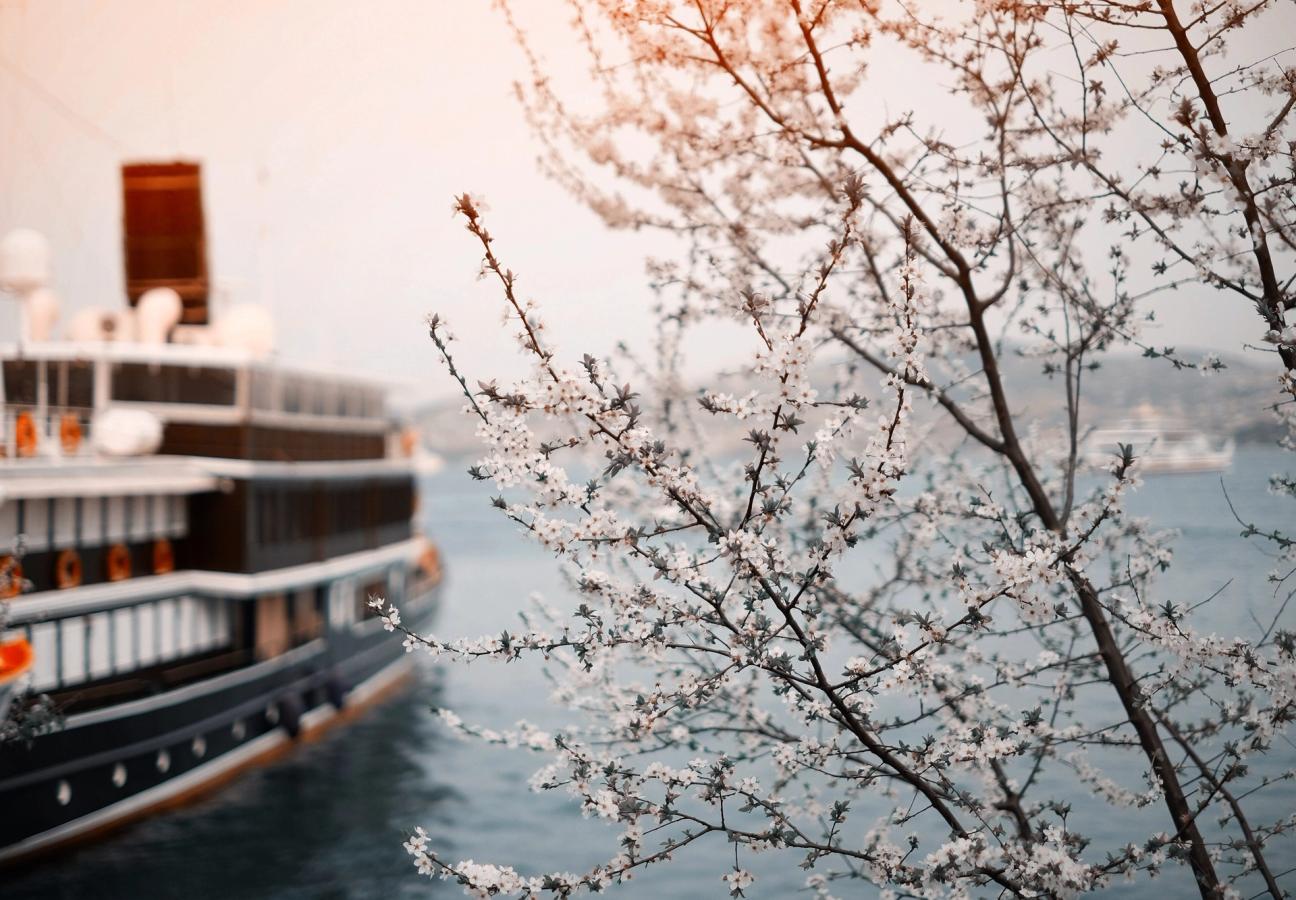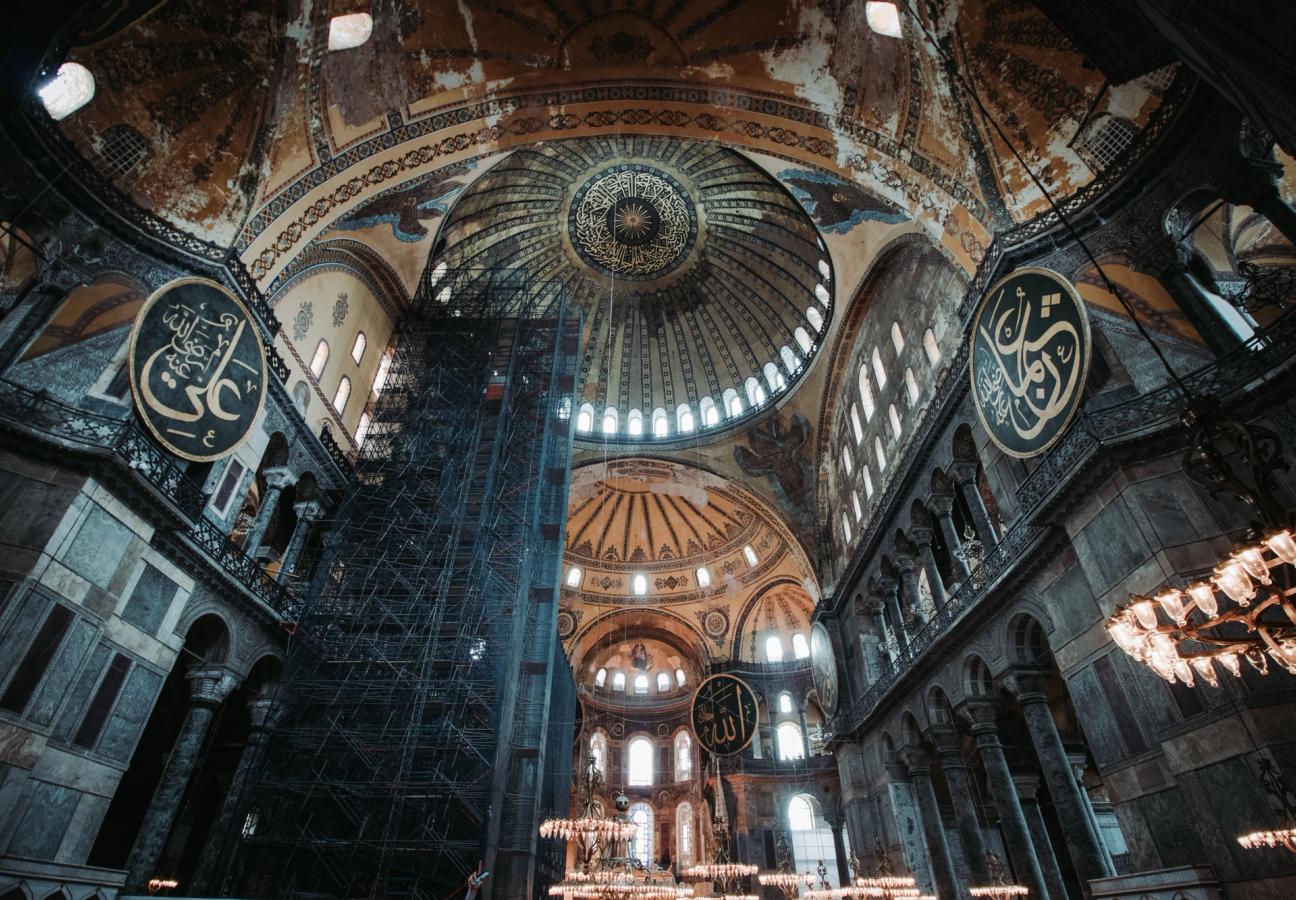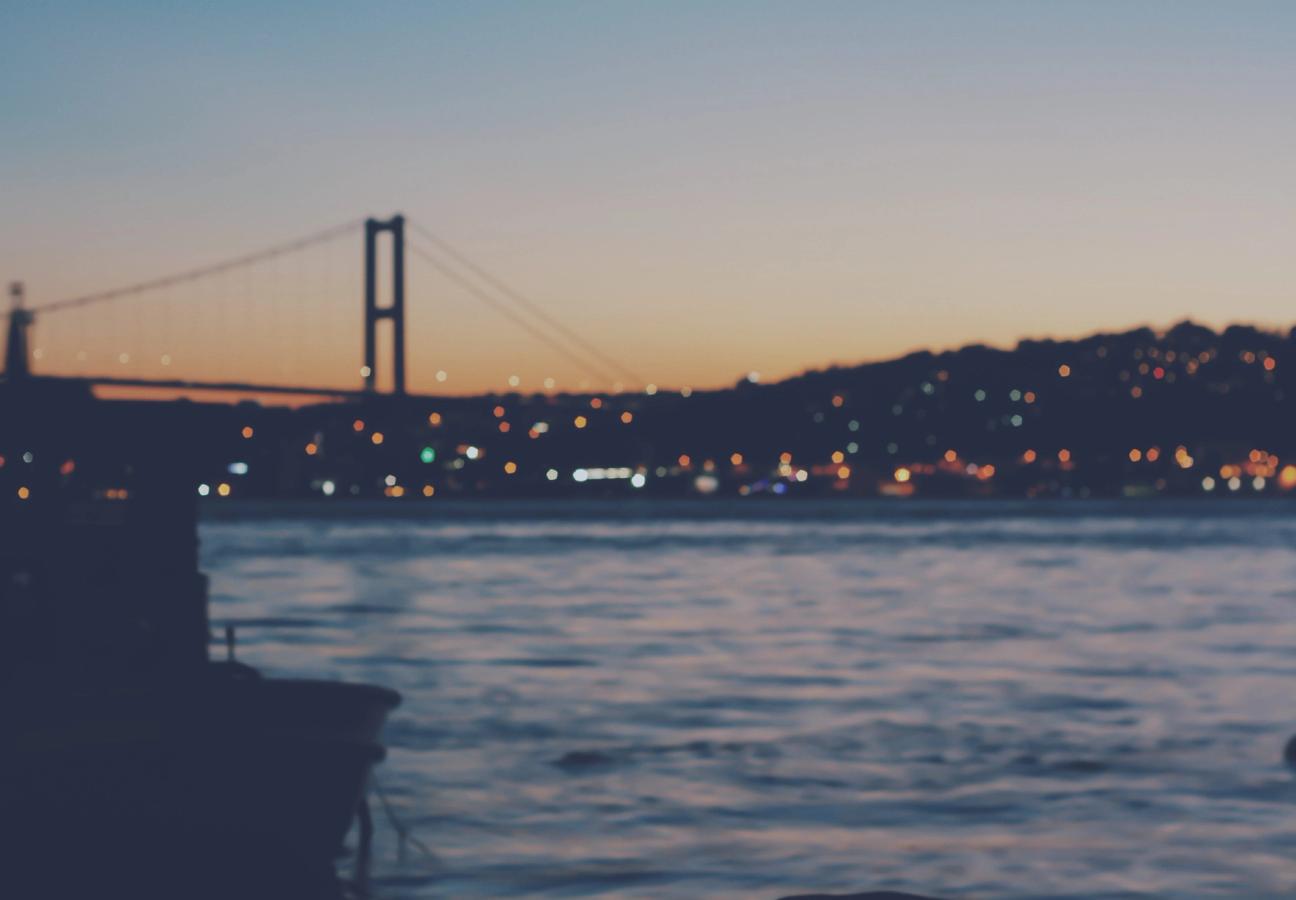

Words: Jonathan Wells
It sounds tenuous. On a stormy Sultanahmet Square, a small Turkish man is doing his best to convince me that the proverb ‘All roads lead to Rome’ is actually a cryptic reference to Istanbul. I’m having none of it.
But, like the persistent rain, he presses on. This, he gesticulates wildly, was the centre of the Roman Empire. There’s an Egyptian Obelisk over here, he cries, and the remnants of a Byzantine hippodrome over there. It’s all completely plausible!
With wet hair and wild eyes, the local is doing little to convince me. He seems to have about as good a grip on Turkish history as he does on his umbrella. Should I just wander away? Go and take shelter in the Hagia Sophia? Probably not. Instead, I nod — because his concerted conviction and my wet socks are starting to wear me down. Perhaps, I think to myself, there is a nugget of truth in his ramblings.
With over twenty-seven centuries of history and mysteries to unravel, who’s to say the phrase wasn’t unwittingly misinterpreted in the bustle of the Grand Bazaar? Who am I to presume that this sprawling, squawling city wasn’t the intended subject of that time-honoured saying? After all, given everything Istanbul has shown me this week, I’ve learnt that the place certainly wasn’t built in a day.
International waters

The cormorants are gathering; as are the storm clouds. It’s Thursday, and weather-beaten fishermen are squinting down sceptically at me from blue-iron bridges — their rods reaching out speculatively into the fog. Captain İbrahim, all stubble and waxed canvas, gives me a calloused hand onto his boat, promising: ‘This is best way to see city.’
And what a city it is. Istanbul is the thread by which Asia and Europe hang together — and the Bosphorus on which we’re bobbing is the vital stretch of international water that connects them. Over 16 million people live in Turkey’s largest city and, although the predominantly suburban Asian side sits somewhat in the shadow of the grungy European metropolis, every neighbourhood has its own exciting architecture, culture and cuisine.
Not that food is much on my mind. As we putter past boats heaving and groaning against their moorings, my stomach lurches with them. With all this weather, the Bosphorus seems to have forgotten to glow its usual blue, and the ‘Golden’ Horn estuary that divides the European bank is shining a less resplendent brown. The queasiness will pass, says İbrahim, flashing a sea-legs smile.
It soon does, although I put that down less to my mariner’s constitution and more to the spectacle of the city. Through the mist and the mizzle, I can make out parades of imperial pavilions sitting pretty alongside old Sultans’ palaces. Flags wave at us limply, and the revolving doors of grand hotels spin with the ghosts of illustrious past guests.
Bridges soar above the seabirds, rusting steamers puff past and sharp minarets stab yet more raindrops from the sky. It’s beautiful — like a city pieced together from spy novels and the remnants of old film sets. Even so, İbrahim says that many Istanbulites have never even crossed the Bosphorus, and locals still call their opposite side ‘The Other’.
We drift by the riverside husk of Reina Nightclub — the sobering site of a 2017 terrorist attack. Here, a gunman delivered a last damning indictment on Istanbul. Tourism and terrorism make for uncomfortable bedfellows, frowns İbrahim.
But, two years later, the city is on the mend. The vast frames of new hotels are sprouting up along the banks. The state-of-the-art Galataport cruise terminal is set to turn the tide on tourism by 2020. And, most days on the Bosphorus, you can’t see the blue for the boats. But not today, laughs Captain İbrahim. Today it’s horrible.
Turkish Turquoise tiles (or the plates of Pandeli)
Some time later, after the triumphant return of my appetite, I find myself lost below the zebra-striped arches of the Mısır Çarşısı spice bazaar — late for a lunch reservation.
And the stalls are doing nothing to assuage my hunger. Turkish chillies the size of bananas hang in bunches from the walls, and sacks swell with cumin, pungent köfte baharı and black nigella seeds. Sandcastles of cinnamon sit on ramshackle tables, yellow clouds of saffron drift above buyers, and pyramids of piquant ginger lean at impossible angles.
It really grabs you by the tastebuds. But Pandeli, my destination and one of the oldest restaurants in the city, waits for no man; at 117-years-old, it has quite lost its patience. Thankfully, a flight of stone steps and a sincere apology later, I am shown to my seat.
Pandeli’s Turkish turquoise tiles would have made for a good tongue-twister — if I wasn’t already too busy twisting mine around the exquisite celery root starter. Instead, I content myself watching white-tuxedoed waiters glide around the dining room, spinning and balancing their trays across a terracotta-tiled floor.
From the Art Deco script on the menu to the glass chandeliers above, there are shades of the Orient Express about Pandeli. And it’s no wonder – Agatha Christie dreamt up her most famous novel in the nearby Pera Palas Hotel, and the iconic locomotive itself served the city until 1977.
"I content myself watching white-tuxedoed waiters glide around the dining room..."
But the restaurant is legendary in its own right. It has enchanted diners from Audrey Hepburn and Sean Connery to Queen Elizabeth II. Even the founder of the Turkish Republic, Atatürk, adored the dishes so much that he frequently requested they be taxied by train to his offices in Ankara — the nation’s smaller capital.
I don’t blame him. As my round-faced waiter starts singing out the menu, I can hardly contain myself at his lyrical suggestions of oven baked sea bass in curl paper, rice stuffed vine leaves and the kadınbudu meatballs.
And, as I wait for the plates, I skim the menu for myself. Turkish cuisine seems to have been cooked up from an adventurous blend of diverse ingredients. A pinch of Central Asian influence here, a drop of Balkan heritage there — all mixed together by Ottomans and garnished with a European twist.
Today, olive oil is produced by the barrel in Western Turkey, pomegranates are grown on the coast of the Aegean Sea and pistachio nuts are harvested in 56 of the 81 provinces. The country is the world’s largest exporter of cherries, figs, hazelnuts; the list goes on.
But, while many of these ingredients are exported across the globe, some don’t make it further than the plates of Pandeli. And so it is that, after scaling a pantheon of flavours (do try the pan-fried lamb’s liver) and fighting my way out through drifts of clotted buffalo cream, I find myself back in the spice market.
The colours seem bolder, the smells richer. Pandeli has heightened my senses to an almost intoxicating degree — no mean feat for a restaurant whose proximity to a mosque outlaws alcohol on its premises. But religion remains a key part of Turkish culture, as the rain would soon drive me to discover…
The cross-eyed cat

Jacket pulled over my head, I jog off through the puddles. All roads lead to Istanbul, the small Turkish man cries out after me! But I’m more interested in finding shelter from the storm than listening to any more idiomatic theories. I’m off to Istanbul’s skyline-dominating, postcard-selling (and hopefully watertight) main attraction; the Hagia Sophia.
Built in the sixth century, the Hagia Sophia stands testament to this city’s religious and cultural diversity. Its door hangs heavy, a bronze-clad slab of fortitude reclaimed from an old Pagan temple. On the Byzantine basilica’s walls, Arabic script sweeps ideas of Islam — and Greek Orthodox frescoes of Christ fade upon ancient, alabaster walls.
As with the city’s diverse cuisine, it seems that all religions also converged on Istanbul — and this grand, cavernous cathedral is the monument in which they all met. The worn marble floor ripples out in front of you like water, and the vaulted, decorated domes dare you to crane your neck to breaking point. The place radiates such spirituality it seems a shame that Atatürk secularised it in 1935.
Now, in its modern capacity as a museum, the Hagia Sophia is attempting to teach younger generations how religion shaped their city. But most visitors appear to be less interested in religious history and more excited by Gli, an old cross-eyed cat who has made the landmark her home — and has over 13,000 followers on Instagram.
Despite indications that atheism is increasing, there are over 3,000 mosques in Istanbul today. Tannoys still crackle their calls to prayer and muezzins still trill from minarets. The devout continue to descend on a dizzying array of mosques — from classical Ottoman giants to colourful backstreet sanctuaries. And each of these holy places has its own unique architectural quirks and idiosyncrasies.
Some festoon their domes with the pungent shells of ostrich eggs – the smell of which deters spiders from spinning their webs in hard-to-clean areas. Some house the best preserved examples of ancient Iznik tiles. And some were even designed with channels in their domes, down which candle soot is funnelled to one corner — and harvested by local calligraphers to be turned into ink. As I peer around the honeyed shadows of the Hagia Sophia, I wonder: how many of these precise features could I be missing in the most famous mosque of all?
I eventually decide to give up searching for any architectural enigmas and, as I walk by a troop of tourists trying to coax a purr out of Gli, it seems fitting to me that we should allow the Hagia Sophia to hold onto some of its secrets. After all, they’ll always be there — for those who value Islam over Instagram.
Walking back across a slightly less stormy Sultanahmet Square, I look back at the vast landmark. From the magnificent cathedrals of Europe to the gilded temples of the Far East, I always find myself curiously moved by places of worship — despite not holding any particular beliefs or faith myself. That said, I did have a divine moment on the way — albeit in the guise of something more syrupy.
All aboard the Karaköy carousel
Why does no-one ever mention the stray dogs of Istanbul? It’s a thought that pops into my head as afternoon turns into evening, and I’m crossing one of the Golden Horn’s many blustery bridges. There are street dogs everywhere in this city — and they are huge. They sit on street corners like docile wolves; doe-eyed, lop-eared and, like the one that has been following me for the last ten minutes, remarkably nonchalant.
But he won’t be happy when he finds out where we’re going. On the banks of the Bosphorus, Karaköy Güllüoğlu is the greatest, busiest and sweetest baklava shop in Istanbul — with two hundred years of experience under its apron strings, a peerless reputation and, presumably, a strict no street-dog policy. Thankfully, he soon loses interest in me — instead attempting a stealth raid on a fisherman’s lunchbox.
In the dying light, I wend my way along the riverside to the commercial quarter of Karaköy. It is here that the Güllü family decided to set up shop, and where that very same shop has been making jaws drop and teeth ache for decades. From the star-tiled floor to the pink-panelled ceiling, the place is packed with layer upon layer of sweet pastry. And, from walnut and hazelnut treats to desserts with chocolate and cream, there are more baklava flavours and variations here than there are umlauts above the door.
Some have crinkled filo domes, while others shine slick with sugar. Many have been crafted to look like dumplings, cigars or seashells. The signature pistachio-infused baklava even glow green — and look a little like the stuffed vine leaves I enjoyed earlier at Pandeli. I order a coffee, a selection of pastries, and find a table.
"There are more baklava flavours and variations here than there are umlauts above the door..."
Baklava, Turkey’s national dessert, is a way of life in Istanbul. Like the hours whiled away in hammams or long conversations had over backgammon boards in Turkish teahouses, friends and colleagues also frequently meet up and recharge over these small sugary bites. But baklava is not considered a treat to be savoured, and most customers sit for mere minutes before moving on. The turnaround of tables reflects this, and the Karaköy carousel of professionals, tourists and locals spins at a blistering pace.
But what else is to be expected when sugar levels are so high? As I softly crunch into each of the ambrosial pastries, I feel energised enough to jump up myself. And that’s before I’ve even taken a sip of my coffee…
The inky, cardamom-infused cup on the table before me is another of the country’s national treasures. Traditionally, Turkish coffee is prepared using incredibly finely ground beans, and boiled with sugar, spices or natural seasonings for the most robust brew. Drained to its grounds, I think this particular cup could have squared off against my baklava in the flavour stakes — and that’s no mean feat.
But, before I can pit any more Turkish delicacies against each other, I must leave. There may be a few torn corners of filo left on my plate but, if I stay any longer, I’ll break the flow of baklava-loving locals looking for seats. And you can’t disrupt the system of Karaköy Güllüoğlu — it’s almost as delicate as the pastry itself.
Do all roads lead to Istanbul?

The traffic is at a standstill. Cabs and cars are sounding their horns, and the day’s fug has given way to night-time fog. Above the streets, roof-mounted neon signs sear their red glare across the city, and the last call to prayer is crackling to a close.
I’m sitting at a roadside bar, turning a slim glass of Raki between my thumb and forefinger. The tart Turkish spirit is affectionately called ‘lion’s milk’ by locals; partly because of its curiously cloudy colour, the wiry barman tells me — but mostly because you have to be brave to drink it. As I stand to leave, he inches out from behind the bar to wipe down my table, passing a loud American who is trying — and failing — to fold up a big flapping map of the city. Sometimes Istanbul can drive you mad, the barman smirks.
But it’s a wondrous madness. The ‘national’ cuisine was mixed in a melting pot. The ancient religions have ripped up the holy rule books. The banks of the Bosphorus are overflowing with different neighbourhoods and nationalities. And the streets throb with diverse languages, stray dogs, turquoise tiles, Instagram cats, black coffee and clouds of dizzying spices.
So maybe the small Turkish man from earlier was right. Because, call it what you like — Lygos, Constantinople, Byzantium, Augusta Antonina — this city is a cultural jigsaw. It has slipped through the fingers of countless regimes and religions, and amassed a millions-strong society from across the globe. Back on a starry Sultanahmet Square, all becomes clear. Not all roads do lead to Istanbul, but neither do they need to — everyone’s found themselves here anyway.
Looking for a taste of more European delicacies? Follow us into the dark, delicious world of the international truffle trade…


